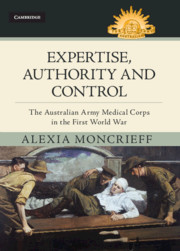Refine search
Actions for selected content:
15418 results in Military history
Chapter 3 - The Western Front in 1918
-
- Book:
- Expertise, Authority and Control
- Published online:
- 10 February 2020
- Print publication:
- 11 February 2020, pp 80-108
-
- Chapter
- Export citation
Bibliography
-
- Book:
- Expertise, Authority and Control
- Published online:
- 10 February 2020
- Print publication:
- 11 February 2020, pp 207-213
-
- Chapter
- Export citation
Introduction
-
- Book:
- Expertise, Authority and Control
- Published online:
- 10 February 2020
- Print publication:
- 11 February 2020, pp 1-18
-
- Chapter
- Export citation

Expertise, Authority and Control
- The Australian Army Medical Corps in the First World War
-
- Published online:
- 10 February 2020
- Print publication:
- 11 February 2020
Copyright page
-
- Book:
- Charles E. Callwell and the British Way in Warfare
- Published online:
- 19 December 2019
- Print publication:
- 16 January 2020, pp iv-iv
-
- Chapter
- Export citation
5 - ‘I Did My Best to Throw Cold Water on the Scheme as a Whole’: Charles Callwell and the Dardanelles
-
- Book:
- Charles E. Callwell and the British Way in Warfare
- Published online:
- 19 December 2019
- Print publication:
- 16 January 2020, pp 159-205
-
- Chapter
- Export citation
Bibliography
-
- Book:
- Charles E. Callwell and the British Way in Warfare
- Published online:
- 19 December 2019
- Print publication:
- 16 January 2020, pp 249-270
-
- Chapter
- Export citation
Introduction - Charles E. Callwell and British Strategy
-
- Book:
- Charles E. Callwell and the British Way in Warfare
- Published online:
- 19 December 2019
- Print publication:
- 16 January 2020, pp 1-19
-
- Chapter
- Export citation
Contents
-
- Book:
- Charles E. Callwell and the British Way in Warfare
- Published online:
- 19 December 2019
- Print publication:
- 16 January 2020, pp v-v
-
- Chapter
- Export citation
Acknowledgements
-
- Book:
- Charles E. Callwell and the British Way in Warfare
- Published online:
- 19 December 2019
- Print publication:
- 16 January 2020, pp vi-viii
-
- Chapter
- Export citation
Index
-
- Book:
- Charles E. Callwell and the British Way in Warfare
- Published online:
- 19 December 2019
- Print publication:
- 16 January 2020, pp 271-278
-
- Chapter
- Export citation
6 - Not ‘One of That Band of Dug-Outs Who Became Dug-Ins’: Charles Callwell, the War and Retirement, 1914–28
-
- Book:
- Charles E. Callwell and the British Way in Warfare
- Published online:
- 19 December 2019
- Print publication:
- 16 January 2020, pp 206-239
-
- Chapter
- Export citation
Conclusion
-
- Book:
- Charles E. Callwell and the British Way in Warfare
- Published online:
- 19 December 2019
- Print publication:
- 16 January 2020, pp 240-248
-
- Chapter
- Export citation
2 - ‘An Art by Itself’: Charles Callwell and Small Wars
-
- Book:
- Charles E. Callwell and the British Way in Warfare
- Published online:
- 19 December 2019
- Print publication:
- 16 January 2020, pp 37-80
-
- Chapter
- Export citation
4 - Khaki-Clad Maritime Theorist: Charles Callwell and Amphibious Warfare
-
- Book:
- Charles E. Callwell and the British Way in Warfare
- Published online:
- 19 December 2019
- Print publication:
- 16 January 2020, pp 113-158
-
- Chapter
- Export citation
1 - Callwell’s Early Career
-
- Book:
- Charles E. Callwell and the British Way in Warfare
- Published online:
- 19 December 2019
- Print publication:
- 16 January 2020, pp 20-36
-
- Chapter
- Export citation
3 - ‘Another Page in the History of Tactics’: Charles Callwell and the South African War
-
- Book:
- Charles E. Callwell and the British Way in Warfare
- Published online:
- 19 December 2019
- Print publication:
- 16 January 2020, pp 81-112
-
- Chapter
- Export citation

Charles E. Callwell and the British Way in Warfare
-
- Published online:
- 19 December 2019
- Print publication:
- 16 January 2020
Contents
-
- Book:
- The Other Wars
- Published online:
- 28 November 2019
- Print publication:
- 12 December 2019, pp v-v
-
- Chapter
- Export citation
Conclusion
- from Part II - Memory
-
- Book:
- The Other Wars
- Published online:
- 28 November 2019
- Print publication:
- 12 December 2019, pp 220-225
-
- Chapter
- Export citation
